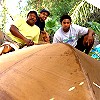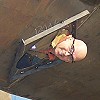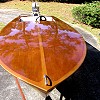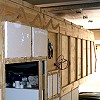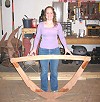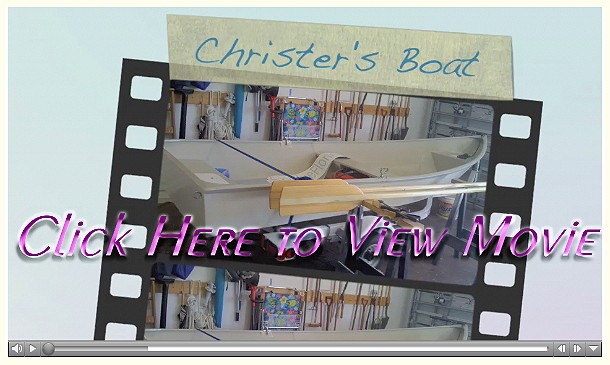

A place to share YOUR boat building story
Glen-L Marine Designs - 9152 Rosecrans Ave. - Bellflower, CA 90706
 In this issue
In this issue
-
In Memory of My Mother…Vera
Irene Witt
by Gayle Brantuk
-
Mr. Schott's Superb Sea Trip
by Ken Schott
-
Glen-L Boatbuilder of the
Month
-
Response to the "Tool
Junkie" by John Downing
-
Designer's Notebook: Does Your
Transom Droop?
-
The Haulout by ArtDeco
-
Photos sent in since the last
WebLetter...
-
Glen-L Walk-in Customer of the
Month
-
Shop Talk: Impact Drivers vs.
Driver Drills
-
Recent email
-
What Kind of Bait?
GLEN-L Update
My how the months fly by! It's almost Spring and I'm
sure many thoughts are turning to just how soon we can get
our boats out on the water. At Glen-L we are eager to hear
about all of your adventures, both in constructing and in
enjoying your boats out on the water.
This month's WebLetter holds a lot of interesting
content, because several of you have sent in articles for
everyone to enjoy...
- Gayle has written a tribute to her wonderful mother
- Ken Schott sent in a great story involving his Double Eagle
- Greg Kelso and the Land of Lincoln Power Squadron's experiences with their Tubby Tug
- John Downing's confession about... well, you should read it for yourself...
Until next month . . .
Editor
In Memory of My Mother…
Vera Irene Witt
by Gayle Brantuk
"MRS. MARINE" HAS PASSED AWAY
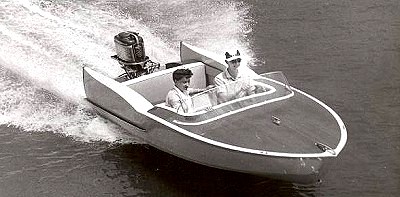 yes, "Mrs. Marine", as she was
called at times throughout the years, has passed away. Since
the family business name is Glen-L Marine after Dad's
name, many assumed mom's last name to be
"Marine"…
yes, "Mrs. Marine", as she was
called at times throughout the years, has passed away. Since
the family business name is Glen-L Marine after Dad's
name, many assumed mom's last name to be
"Marine"…
My mom was the best mom in the world, as I must have told
her a hundred times. She came from a large family of eight
children of which there were two sets of twins and mom was
one of them. She and her sister Vena were fraternal twins
which means they didn't really look anything like each
other but they were very close. The other set of twins was
Uncles Billy and Bobby and they are identical mirror twins.
Mom would say it was like looking into a mirror-one was
right-handed, one was left-handed.
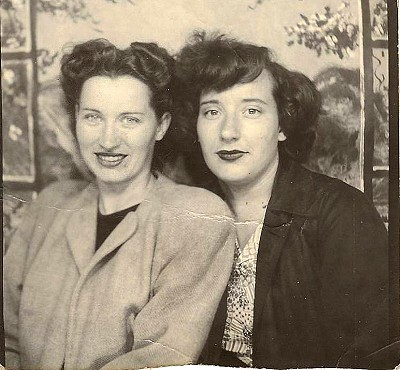 Mom grew up in the
small rural town of Pawnee Rock, Kansas where she went
through school, finishing up High School in Bremerton,
Washington. Mom and Vena moved to Oceanside, California after
high school and got jobs as operators for the phone
company.
Mom grew up in the
small rural town of Pawnee Rock, Kansas where she went
through school, finishing up High School in Bremerton,
Washington. Mom and Vena moved to Oceanside, California after
high school and got jobs as operators for the phone
company.
Years later, Mom was working at a drugstore when she finally
met my father. At that time, she was divorced with a young
6-year old daughter, Janet. Mom used to say that Dad seemed
to need an awful lot of toothpaste and kept coming into the
drug store to pick that up while she was working. Mom and Dad
were married in 1956.
Mr. Schott's Superb Sea Trip
by Ken Schott, Double Eagle Builder
BUILDING A DOUBLE EAGLE IS FUN EVEN BEFORE IT'S DONE
My work is secure for the moment,
too secure actually; working too much overtime to finish the
boat.
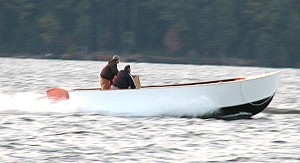 I took the Double Eagle out in some tough seas and
about that time I was thinking about the bilge pumps. With
this open cockpit boat in 5-7 foot seas, the whole idea of a
big one coming over the bow seemed a possibility. Bilge
pumps, or, ummm, "crash pumps" really came to
mind.
I took the Double Eagle out in some tough seas and
about that time I was thinking about the bilge pumps. With
this open cockpit boat in 5-7 foot seas, the whole idea of a
big one coming over the bow seemed a possibility. Bilge
pumps, or, ummm, "crash pumps" really came to
mind.
But, this hull took it all in stride. I did notice that if
the bow got plunged into a big wave, it would split the wave
right on up to the sheer, and as the wave parted, the
buoyancy lifted at the same time, so she never took on any
water.
This kind of weather is why I chose the Lobster boat running
hull. Thus far she has lived up very well to the 'sea
kindliness' description in the Glen-L catalog.
Without a doubt, your design can take more punishment than I
can. On the run out, I was running about 20 mph into a 25 kt
wind. So, the wind was making my eyes water at the same time
the wind/spray was covering my glasses. When I could not
indentify a buoy any longer, I turned back for home and the
downwind run. The seas seemed bigger on the downwind run
since the boat wanted to go surfing if I slowed down. Surfing
was fun, but I powered it up to get on home for dry clothes.
This is where it got interesting running with a lot of power
on in a following sea.
Some of the waves were big enough to look over amidships and
look down into the trough. After awhile this downwind running
was kinda fun and I began playing with the sea going running,
then across, the seaway. 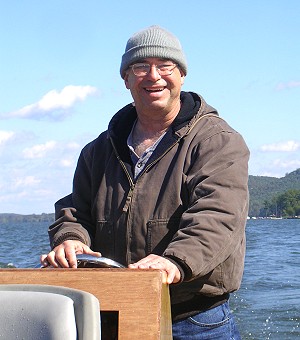 About this time, the
evening sun had a row of channel markers lit up bright. What?
channel markers? Where was I? There ain't any markers on
the way back to the boat ramp (the ramp where my trailer was)
-
About this time, the
evening sun had a row of channel markers lit up bright. What?
channel markers? Where was I? There ain't any markers on
the way back to the boat ramp (the ramp where my trailer was)
-  Aw crap!!
Aw crap!!
So now I go to the nearest marker for a number and pull out
a paper chart to look at. Keep in mind that everything in the
boat is already wet; the wind already blew a plastic bailing
bucket out. This paper chart goes away with the wind and all
I got in my hand is some paper mush. I know I am not too far
from the mouth of St. Catherine Sound because I can see
the mouth, but how in hell did I get into the ICW
headed for Florida?
All that don't really matter 'cause I am now low on
gas, cell phone in the truck, it's getting late, and
there isn't anybody else out here on a day like this. I
went back out into the sound and started for home all
over.
So, ummmm, yeah, the boat can take a lot more punishment
than I can.........
and his Project Registry entries.
Glen-L Boatbuilder of the Month
Land of Lincoln Power Squadron - Tubby Tug
Illumination began as a
set of plans purchased from the Glen-L Marine Company in
Bellflower, California. Funding for its construction was due
to a generous grant from the Boat US Safety Foundation.
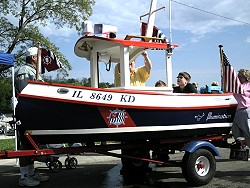 Land of Lincoln Power Squadron, a unit of the
United States Power Squadrons, based in Springfield,
Illinois, began construction of the plans called "Tubby
Tug" in February, 2007. Members of the Land of Lincoln
Power Squadron (LLPS) voted to begin this project as a means
to promote public awareness of USPS and its goal of
increasing boating safety through fellowship, education and
civic contribution. In addition, the vessel would be used as
a visual aid for boating safety training helping to
demonstrate proper boat handling, use of compass and GPS for
navigation and proper protocol for VHF marine radio
usage.
Land of Lincoln Power Squadron, a unit of the
United States Power Squadrons, based in Springfield,
Illinois, began construction of the plans called "Tubby
Tug" in February, 2007. Members of the Land of Lincoln
Power Squadron (LLPS) voted to begin this project as a means
to promote public awareness of USPS and its goal of
increasing boating safety through fellowship, education and
civic contribution. In addition, the vessel would be used as
a visual aid for boating safety training helping to
demonstrate proper boat handling, use of compass and GPS for
navigation and proper protocol for VHF marine radio
usage.
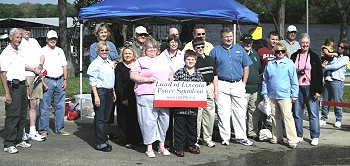 LLPS members collectively cut, sealed and
assembled 1/4" inch marine-grade
plywood for the sides and 3/8" marine-grade plywood for
the bottom. The cabin was built and installed. The entire
vessel was encapsulated with fiberglass and painted with
water-based epoxy paint. The vessel was completed in early
May, 2008 and was christened and launched on May 17, 2008 in
Springfield, Illinois to kick off 2008 National Boating
Safety Week. Since that time it has been seen in local
parades, the 2008 Illinois State Fair in Springfield and used
in various boating safety classes. Illumination is a
working boat and is equipped with all the necessary equipment
to meet or exceed U.S. Coast Guard standards. It has floated
on several bodies of water including the Mississippi
River.
LLPS members collectively cut, sealed and
assembled 1/4" inch marine-grade
plywood for the sides and 3/8" marine-grade plywood for
the bottom. The cabin was built and installed. The entire
vessel was encapsulated with fiberglass and painted with
water-based epoxy paint. The vessel was completed in early
May, 2008 and was christened and launched on May 17, 2008 in
Springfield, Illinois to kick off 2008 National Boating
Safety Week. Since that time it has been seen in local
parades, the 2008 Illinois State Fair in Springfield and used
in various boating safety classes. Illumination is a
working boat and is equipped with all the necessary equipment
to meet or exceed U.S. Coast Guard standards. It has floated
on several bodies of water including the Mississippi
River.
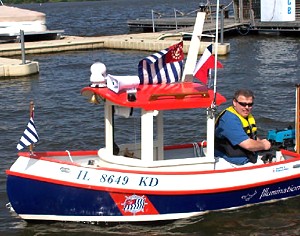 Illumination carries the required
navigation lights for night-time operation and is outfitted
with a lighted compass, a remote control searchlight and VHF
marine radio. Also onboard is a first aid kit and Coast Guard
approved fire extinguisher. A GPS unit can also be mounted on
the dash to assist in navigation. The center stern seat has a
bilge pump enclosed and there is a separate storage
compartment in the bow. For added safety, the bow
compartment, center seats and rear seats (port &
starboard) have been filled with flotation foam making the
boat virtually unsinkable.
Illumination carries the required
navigation lights for night-time operation and is outfitted
with a lighted compass, a remote control searchlight and VHF
marine radio. Also onboard is a first aid kit and Coast Guard
approved fire extinguisher. A GPS unit can also be mounted on
the dash to assist in navigation. The center stern seat has a
bilge pump enclosed and there is a separate storage
compartment in the bow. For added safety, the bow
compartment, center seats and rear seats (port &
starboard) have been filled with flotation foam making the
boat virtually unsinkable.
The Tubby Tug design is nine feet in length and has a beam
of 4½ feet. It is designed to carry 600 pounds which
equates to four adults and is rated for up to a 5 HP engine.
Currently, Illumination has no engine, however, once
funds become available the steering unit will be utilized
with the new engine to enable helm control of the vessel.
Greg also supplied us with more information as follows:
The article pretty much explains who we are and what we did.
We took over three hundred pictures during the build and
launch process.
The boat was inspected and licensed by the IL DNR and was on
display at the Illinois State Fair. We probably had at least
a thousand kids sit in it and play with all the bells and
whistles. Now it will be on display at the Chicago Boat &
RV show, the Chicago Strictly Sail show and the Schaumburg
Boat Show. Then, on to the Peoria Boat Show and back in
Springfield for our show. We plan to make the rounds of local
lake clubs and parades this year as well.
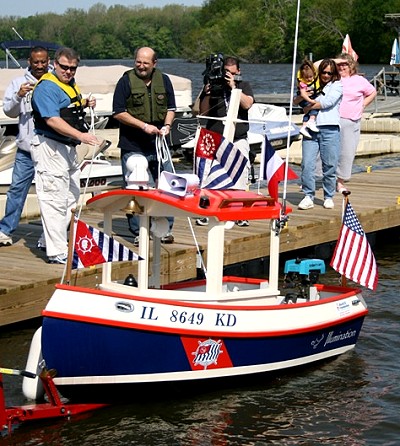
Like all the other people who post pictures and experiences, it's incredible the attention this boat draws both on the water and towing down the road!
and learn about the United States Power Squadrons.
Response to the "Tool Junkie"
by John Downing, Amherst, New Hampshire
D ear Glen,
Yes, I too am a "Tool Junkie," but I do love to
rehabilitate and use them. Power tools are so much more
convenient and fast, but sometimes, too fast and too
convenient, and actually, too darned messy!
For example, take the power sander. Yep, it sure works
great, but you know a properly sharpened cabinet scraper
works as well, if not better, and you are not fighting all of
that sawdust!
The power jointer is a real convenience, especially at
trimming your finger nails and those unsightly and obviously
unneeded finger tips. However, a well-tuned plane is a thing
of beauty and a joy forever!
Power saws can genuinely let you make small pieces of wood
out of big ones, really, really fast. But a well-sharpened
hand saw cannot be beat for trimming, particularly small
items and tough to get at places.
The point of this is that most hand tools are not used
because they come from the factory poorly tuned and/or
sharpened, and sharpening is something that must be
diligently practiced in order to gain the skill you need. I
used to teach a class in preparing a wood plane for use.
Except for Lee-Nielson, most new hand planes are at best,
kits. They must be taken apart, cleaned, the soles lapped and
flattened, the frog filed and cleaned up, the blade properly
sharpened and the chip-breaker/blade union cleaned up. Most
folks buy a new plane, adjust the blade, try it out and
realize it is a lot of work for little result and so the
plane goes on the shelf until the kids hold a garage sale
after dad has gone to that woodworking shop in the sky.
Don't even get me started on sharpening a hand saw!
Bottom line? For most folks, the tool is just that, a tool.
It is a means to an end. In this forum that means getting
afloat on a vessel of your own creation. For some of us,
tools are more than just a means to an end. For us, the
journey is just as important as the destination, and the feel
of a properly tuned and sharpened plane, cutting a
translucent shaving from a long, white oak board, can only be
described with one word...sensuous!
I am a Scouter in the Boy Scouts of America. I like to teach
woodworking and I focus as much as possible on hand tools.
They are safer, better controlled and teach the basics to
young apprentices. My goal for this coming summer is to build
a treadle lathe for the boys to use in learning to turn wood.
When they are older, they will most likely transition to
power tools, but the hours spent straddling a shaving horse,
shaping something with a drawknife and spokeshave, and then
chucking it into a treadle lathe to finish the product will
be remembered and cherished, and really, they will remember
the feel of the tools and the wood and the relative quiet
that is associated with the use of hand tools.
When I started this letter, I had a humorous intent, but I
find that the difference between hand tool and power tool
users is profound and almost religious. As a result, I guess
I got a little carried away with the seriousness of the
subject. The one power tool I will not give up is the
drill/screwdriver. I might be a romantic, but I am not a
masochist!
P.S. Glen, thanks for all of your great columns! The one
about casting was spot-on!
Designer's Notebook: Does Your Transom Droop?
|
The HauloutBoats that live in a slipMust have their bottoms cleaned They all make a yearly trip To a boatyard, that's where I mean When the time came for mine I called up Kettenburg Marine And made an appointment For my sailboat to be cleaned I would take the boat in by seven That's before my job you see They'd clean and paint the bottom To be done that afternoon by three As we approached the dock My wife was at the helm I was up on the bow Confident she knew that realm As I looked into the yard The sun was breaking light The marine railway cradle Was nowhere in my sight It must be under the water I realized all too late We were going way too fast For us to change our fate The keel then hit the cradle We came to an instant stop But I was not hanging on And into the bay I did flop Many of the boatyard workers Laughed because I was wet Seems when they saw us coming They had all placed a bet The boat had minor damage My dignity was shot to hell My wife was very embarrassed And repairs meant a day as well The moral of this story The truth can now be told When sailing into a boatyard It's better slow than bold -ArtDeco |
Photos sent in since the last WebLetter... |
Glen-L Walk-in Customer of the Month
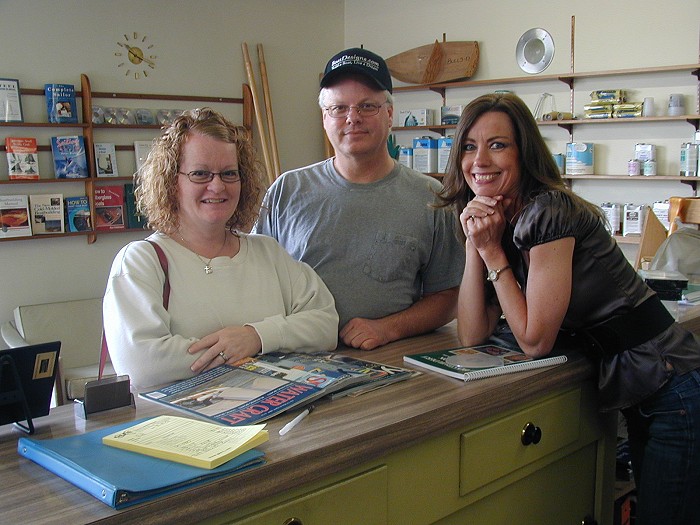
Reed and Traci Daniels of Rigby,
Idaho suprised us here at Glen-L by driving all the way to
Bellflower in order to purchase a "boatload" of
Glen-L products (notice the Glen-L Hat Reed is sporting - don't
you want one too?!). Traci and Reed visited with us at
Glen-L's Intergalactic Center of Operations the morning
of March 19, and were kind enough to share with us pictures
of their Glen-L Crackerbox and Glen-L Monsoon, and regale us with stories of
their adult exploits and childhood memories.
Reed told us that his father was a "hardcore"
boater, and that once when asked if he ever though of using
cavitation plates on his Crackerbox his
dad firmly responded "Cavitation plates are for sissies
- just hold on!!"
Many thanks to Traci and Reed for their warmth and
friendship, and for entertaining Buckshot too!
 the answer to "How do you eat an elephant?" "--- One bite at a time." |
Shop Talk: Impact Drivers
vs. Driver Drills
HOW DO IMPACT DRIVERS "MELT SCREWS IN"?
Until you try one, you simply
won't believe how effortlessly an Impact Driver drives
screws. Unlike driver/drills that simply rotate the drill or
driver bit, Impact Drivers apply a series of high-speed
rotary hammer blows to the driver bit, just like the impact
wrench the tire guy uses to install lug nuts. That rotary
force minimizes the axial force (pushing) required to keep
the driver bit in the recess, so screws seem to just
"melt" right in!
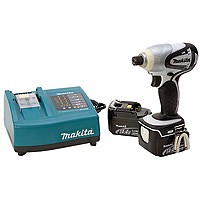
Cordless impact drivers have been gaining popularity for some
time now. Today, it would be hard to find a professional or
serious home shop that didn't have at least one. If
you've priced them, however, you may have noticed that
they fetch a different price than a typical cordless drill.
There's a reason for that: Despite the similarity in
appearance, they're completely different tools. An impact
driver, like the Makita BTD130FW 14.4-Volt Lithium-Ion
Cordless Impact Driver
,
may look like a sort of wimpy drill/driver, but in reality,
it's a much more sophisticated mechanism, and provides an
entirely different fastener driving experience.
How does an impact driver work? There are several variations
in mechanical design, but in essence all impact tools work
like this: A rotating mass in the tool called a
"hammer" is accelerated independently of the
"anvil" - the output shaft that engages with the
head of the fastener. When the hammer has built up a certain
amount of energy, it is brought into contact with the anvil,
creating an impact which instantaneously applies torque to
the fastener. The cycle repeats and repeats, on the order of
thousands of impacts per minute. The result is a high level
of torque delivered to the fastener with very little effort
on the part of the user.
There's really no comparison between an impact driver
and a conventional drill/driver when it comes to fastener
driving force. The Makita BTD130FW impact driver, for
example, delivers a maximum torque of 1240 in. lbs., compared
to less than 400 for a typical cordless drill of the same
voltage. But the more important difference between a
drill/driver and an impact driver is in the delivery. Unlike
a drill, an impact driver transfers high peak levels of
torque directly to the fastener, and very little to the
handle of the tool. Mechanically, the comparison is roughly
the same as driving a nail with a hammer versus pushing one
in with a rock.
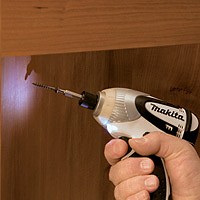
In
terms of fastener driving speed and comfort, most impact
drivers will run circles around a cordless drill. But when
you're in the market for one, the unique qualities of
individual models are worth careful consideration. In actual
practice, the performance of the tool will depend on a number
of factors: motor efficiency, quality and design of the
impact mechanism, and the power and reliability of the
battery. Look for a built-in work area illuminating LED light
- a small amenity that you'll gain a big appreciation for
the first time you operate your impact driver inside an
upside-down boat hull or dark cabin.
Another important consideration is the battery system. As
may be common knowledge by now, lithium-ion batteries offer
several advantages over Ni-Cad or Ni-MH batteries (the other
two types available for cordless tools) including twice the
number of battery life cycles, greatly decreased
self-discharge when stored, less power drop-off toward the
end of the cycle, and best of all, no discharge
"memory", meaning that the batteries don't have
to be run down to nothing periodically for conditioning.
Along with that, they're much lighter than their
nickel-based counterparts and don't pose the
environmental problems on disposal.
If you are using a cordless drill to drive screws, switching
to an impact driver will have an immediate and marked effect
on your attitude toward fastening in general. That's no
exaggeration. In fact, using an impact driver for the first
time can be an almost eerie experience - screws slide in so
effortlessly; there's very little pressure required to
keep the tip of the driver engaged in a screw, and because
torque is transferred more directly to the fastener, very
little sensation of the handle of the tool wanting to twist
out of your grip.
For us boatbuilders who spend a fair amount of our time
driving screws and other fasteners, the payback in speed,
convenience, comfort and reduced fatigue you'll get from
an impact driver will make the investment feel like a
bargain.
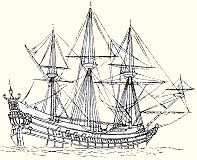
Recent email:
Subject: 14' Driftboat
Date: 13 March 2009
My name is Mark Mariano, Jr. and I am currently building your
14' Driftboat. I am building it in my
carpentry class at the University of Montana, College of
Technology in Missoula, Montana. I am a first-time builder
and am a very lucky guy to be building my own boat for
college credit!
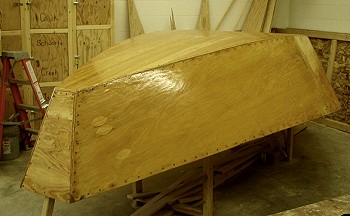 So far I
have built the hull and am now at the fiberglassing stage. I
am racing the clock to beat the spring runoff on the local
rivers and hope to have it on the water by the end of the
'08-'09 school year.
So far I
have built the hull and am now at the fiberglassing stage. I
am racing the clock to beat the spring runoff on the local
rivers and hope to have it on the water by the end of the
'08-'09 school year.
I would like to thank everyone that has posted on the Boatbuilder Forum and the Glen-L family
for their help and support so far. The project has stirred up
a lot of interest within the school and I'm sure that it
will not be the last Glen-L boat that is made in our shop. I
have told everyone about all the help and resources provided.
I will send more pictures as the project comes along.
-- Mark Mariano, Jr.
Missoula, Montana
Subject: Project Registration
Date: 20 March 2009
My name is Matthew Trent and I am building the Glen-L Fancy Free. I hope to name the boat after
my mother in honor of what must have been the most stressful
years of her life - my birth to graduation! I suppose the
name is up to the powers that be. Perhaps I should invest in
a sacrificial lamb and a really good bottle of rum! It
couldn't hurt.
I live in Tacoma, Washington and sail weekly on the Pacific
Northwest's biggest protected saltwater pond. That's
right; the good ole Puget Sound. You could spend a lifetime
gunkholing her shores and never see it all, though it's a
worthy enough mission objective to ensure many thousands of
hours at the till. Har..Har!
I recently retired from the Army and have chosen in sound
body and mind (if I can use the two statements in the same
sentence!) to build a boat myself. I have owned many old
Woodie's, but never delved any deeper than light
restoration. This project promises to be a deeply fulfilling
use of my newly acquired "freedom."
I currently have the hull constructed, and am in the process
of glassing the bottom. This Washington rain prolongs the
cure rate, but I hope to have her painted and righted by the
end of the month. It isn't a large percentage of the
build, but having gotten this far in just six weeks I feel
I'm well ahead of schedule.
-- Matthew Trent
Tacoma, Washington
Subject: Landlocked Boat in Missouri
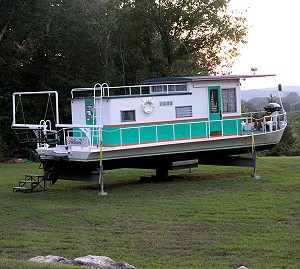 Date: 16
March 2009
Date: 16
March 2009
Also I read all the WebLetters up to WL-106; will finish in the next week. Gayle, the Teleconference was great. Thanks to you all for the work to set it up
-- Brad Schiller, Builder in the corn
Council Bluffs, Iowa
Subject: Drift Boat
Date: 30 March 2009
I can't tell you how much fun we've had. We're considering making this "our thing" and wanted to thank you for your plans. We've been documenting our progress on the Drifter with pictures and would like to put them up on your site when we finish. We'd also like to do the same with our Stripper and whatever bigger model we move onto next.
Thanks. You all have a good one.
-- Douglas Rohde
Hermiston, Oregon
Subject: Thank You
Date: 18 March 2009
I have been very pleased with all the information and products (Minuet, Series 1000 Trailer plans, silicon-bronze screw kit for Minuet, Glen-L 17 plans - not yet built) your company has provided over the years.
Thank you for the truly unique service you provide.
-- Robert Zopp
Richardson, Texas
Subject: Build Your Dream Boat
Date: 15 March 2009
I enjoy your emails, and your “Family Atmosphere.” I think your father started a great company and it is fantastic that you are following in his foot steps.
Attached is a movie clip of me building the Power Skiff 14 (13’4" finished? It shrunk..
 ). I ordered the plans in December, 2008 and
was in the water by late February; the movie will show it all...
I hope you enjoy it.
). I ordered the plans in December, 2008 and
was in the water by late February; the movie will show it all...
I hope you enjoy it.
I built it mostly for the experience and I did learn a lot,
so I am now prepared for the next project. Probably a
restoration project of a larger sailboat, if I can find a
suitable boat.
Kind regards,
Bradenton, Florida
What Kind of Bait?
John went fishing one day but had no luck at all. He
noticed that another fisherman near him was catching
fish one after another. He had to know the secret.
He approached the other fisherman and said,
"Excuse me sir, but would you mind telling me
what sort of bait you are using?"
|
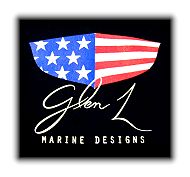
GLEN-L boats, of course
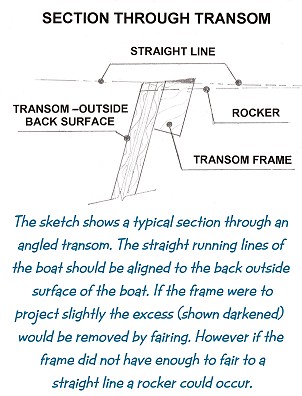 The sketch illustrates a common
"goof." The back outside surface of the
transom must be used to bring the transom bottom
surface up to a straight line in reference to the
frame members. The inner framework of the transom
must be level or slightly higher than the outside
surface for fairing. The sketch shows what can
happen If the transom is canted or at an angle to
the vertical. When the outside surface is not used
to bring it in correct alignment a rocker can result
when the area is faired.
The sketch illustrates a common
"goof." The back outside surface of the
transom must be used to bring the transom bottom
surface up to a straight line in reference to the
frame members. The inner framework of the transom
must be level or slightly higher than the outside
surface for fairing. The sketch shows what can
happen If the transom is canted or at an angle to
the vertical. When the outside surface is not used
to bring it in correct alignment a rocker can result
when the area is faired.
